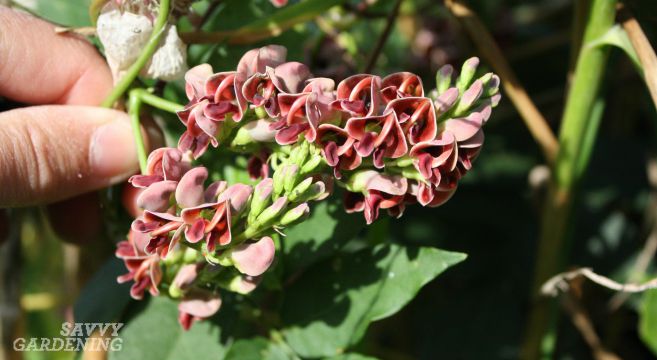This post may contain affiliate links. If you make a purchase through links on our site, we may earn a commission.
If you’re up for an adventure, you may want to consider growing American groundnuts, or potato beans, in your garden next year. This beautiful, perennial vine bears the botanical name Apios americana, indicating that it is indigenous to the Americas. Its native range extends from Northeastern Canada down to Florida and west to Texas and the Dakotas.
Many Native American groups, as well as early European settlers, used this plant’s edible underground tuber as an important food source. The tuber’s flavor is much like a delicious, nutty potato, and they grow like beads on a necklace along the length of the plant’s thick roots. The highly fragrant, burgundy, cream-edged flowers are typical of the legume family to which they belong. They too are edible, as are the plant’s young shoots and seed pods. The flowers are among the most beautiful and curious blooms I’ve ever seen; they’re almost reason enough for growing American groundnuts.

Though some consider this vine to be a pest because it can grow upwards of ten feet in a single season and wrap itself around other plants, I find it to be a beautiful addition to my garden. When given the support of a fence or trellis, the American groundnut is an edible treasure.
Related post: Unusual cucumbers
To harvest the tubers, wait until the plant has been exposed to a few hard frosts (this sweetens the tubers), dig up a section of the plant, and pull the tubers off the roots. Be sure to leave some of the plant intact so that it can return the following season. Harvested tubers can be stored for months in a root cellar or another cool, dry area. Try them boiled, roasted, or pan-fried in butter with some chopped shallots. Yum!
You can buy groundnut tubers for planting from one of these two websites: Norton Naturals and Local Harvest.



I found them growing in the ditches on the new property we bought in the country. I panicked. “Another invasive” I thought. Then I found out it was native and that a few insects used it, making me happy. I also heard that it never took off as a cultivated crop because it takes 2 years to mature, much too long for anyone growing a commercial crop.
Interestingly, there is a small commercial presence in Japan. I did a double take the first time I saw it in the supermarket here.
I just purchased a small number of the tubers as an experiment. Because they have the reputation of almost uncontrollable spreading I plan to plant them in large containers. As they are vines I will either buy supports of some sort or possibly plant them with strong-stalked plants – perhaps maize or Jerusalem artichoke. Do you think any of this will work???
I think growing them in containers sounds like a good idea. However, you’ll have to be sure to insulate the pots for the winter if you live in a cold climate. Or, move the pots into an unheated garage for the winter to offer them a bit of protection.
I planted some tubers last spring and have just harvested a few. Most of the tubers appeared on roots that spread 3 feet or more from the base of the stem. I wonder whether growing them in a pot might be too restrictive. ]
Based on what I’ve seen in the past year of growing them and observing some wild plants, I don’t think the plant spreads rapidly enough to be a concern as an invasive.
I have some that just appeared in my yard. I didn’t know what it was at the time so left it alone because of the amazing flowers. Since, it has spread wildly. Don’t plant it where you want other plants to grow because it, over time, will completely take over. This has been my experience.
They are also available from Fedco Trees https://www.fedcoseeds.com/trees/groundnut-394. Their ordering is done for this season but will open up again in the fall.
I found it growing wild on my property. I love the flowers.
I guess I am growing them unwittingly, I was bush hogging down by the pond and noticed a large area of vines and got off to see what they were. They are just flowering now, the circle of plants is about 50 feet wide. I just think it is odd I never noticed them before.
Thank you for the links where to buy. If you know of other sources for US gardeners, please include them.
I planted some early this year in a planter. They grew very rapidly, 10 ft or more. There were no flowers and I had somehow thought the nuts would be on the vine and they weren’t and they were so voracious that I just pulled them down. I was going to send the photo of what I found in the soil but apparently this site doesn’t accept photos. I may try them again now that I know the “string of pearls” is there underground.